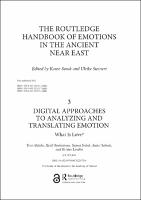Chapter 3 Digital Approaches to Analyzing and Translating Emotion
Proposal review
What Is Love?
Author(s)
Alstola, Tero
Jauhiainen, Heidi
Svärd, Saana
Sahala, Aleksi
Lindén, Krister
Language
EnglishAbstract
This chapter discusses the use of digital tools—in particular, language technology—to study the history of emotions. There are a growing number of annotated text corpora for ancient languages large enough to benefit from computational analysis. This chapter focuses on the cuneiform Akkadian texts available in the Open Richly Annotated Cuneiform Corpus (Oracc) and applies two language-technological methods, Pointwise Mutual Information (PMI) and the fastText implementation of the Continuous Skip-gram model, to a dataset of 7,346 texts. To illustrate the potential of these methods, they are used to analyze the semantic domains of the verb râmu, “to love,” and its derivatives in Akkadian. Because the usage and semantic domains of a word can vary greatly between different genres, the dataset is divided into several genres and the analysis focuses on royal inscriptions, letters, and literary text genres. The results show that, like the word love in English, râmu can denote different aspects of affection and love. It refers, for example, to erotic and sexual relationships between people, affection between family members, the king’s love of justice, and the gods’ pleasure with and acceptance of the king who fulfills divine expectations.
Keywords
Affection; Akkadian; Ancient; Archaeology; Art; Brotherhood; Civilizations; East; Emotions; Expression; Feeling; History; Hittite; Kings; Kingship; Materialization; Mesopotamia; Remains; State; Texts; Theoretical; Translating; Transliteration; VisualDOI
10.4324/9780367822873-6ISBN
9780367407513, 9781032321257, 9780367822873Publisher
Taylor & FrancisPublisher website
https://taylorandfrancis.com/Publication date and place
2023Grantor
Imprint
RoutledgeClassification
Ancient history


 Download
Download